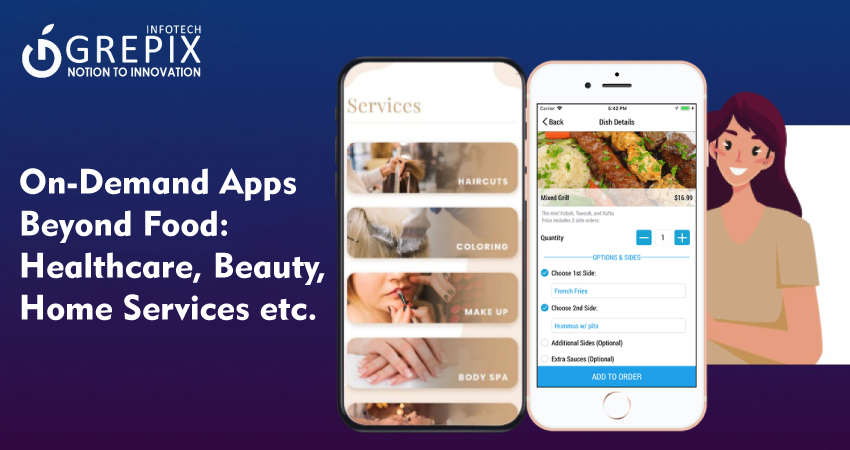On-demand Apps Beyond Food: Healthcare, Beauty, Home Services etc
On-demand apps have revolutionized convenience, with food delivery services leading the early wave. However, this transformative model is rapidly expanding beyond food into critical and lifestyle areas such as healthcare, beauty, home services, and education. These sectors leverage technology to provide instant access to skilled professionals, personalized experiences, and flexible scheduling. As consumers increasingly demand immediacy and simplicity, the on-demand healthcare app, beauty on-demand services, and home services app markets are experiencing exponential growth. This expansion reflects not only changing consumer habits but also tech advancements like AI, 5G, and IoT empowering smarter, faster service delivery.
The on-demand economy has surged beyond food delivery apps into sectors like healthcare, beauty, home services, and education, transforming how consumers access essential services. On-demand healthcare apps harness telemedicine, AI diagnostics, and remote monitoring to enhance patient care conveniently and swiftly. Beauty on-demand services cater to evolving consumer trends with mobile-accessible grooming, wellness, and skincare bookings. Meanwhile, home services apps tap into the booming $5,000+ annual household spend through easy booking of repairs, maintenance, and improvement offerings. These innovations empower users with instant, personalized service access anytime, reflecting a new era of convenience that redefines service delivery. This article explores market statistics, real-life examples, and future growth opportunities in on-demand services beyond food delivery, offering insights for consumers and businesses.
On-Demand Healthcare App Innovations in 2025
The on-demand healthcare app market is booming in 2025 due to rising telemedicine adoption, AI-driven diagnostics, and mobile health integration. With the global telemedicine market projected to reach $160 billion, these apps provide everything from virtual doctor visits to remote monitoring and emergency services. Real-life examples include platforms integrating wearable health devices for continuous patient data and AI virtual assistants reducing wait times and improving diagnostic accuracy.
- Telehealth and remote monitoring reduce hospital readmissions by 15%.
- 5G-enabled healthcare apps enable seamless, real-time high-definition consultations.
- AI-powered chatbots handle 30% of routine patient inquiries with 94% accuracy.
- Cloud-based electronic health records (EHR) improve data access and care coordination.
- Wearable biosensors track chronic conditions, promoting proactive interventions.
A case in point is a cross-platform remote heart-monitoring app integrated with wearable ECG tech, offering real-time data accessibility to clinicians and patients alike, revolutionizing chronic disease management.
Also Read: Accelerating Your Fortune: Becoming a Billionaire in South Africa's Taxi Industry
Beauty On-Demand Services: Trends and Insights
The beauty industry is evolving with beauty on-demand services gaining traction as clients seek convenience, personalization, and wellness integration. The $450 billion global beauty market is growing 5% annually, with mobile apps enabling easy booking of haircuts, skincare, nail treatments, and more.
- Seasonal trends shape beauty demand: hydrating facials and beard grooming in winter; exfoliations and lash extensions in spring; waxing and keratin treatments in summer; restorative treatments in fall.
- Popular services include haircuts, color refreshes, manicures, pedicures, and hydration-focused packages.
- Beauty apps empower salons to manage bookings efficiently and personalize offers based on client preferences.
- Data shows 86% of consumers read online reviews before booking beauty services, emphasizing trust and reputation management.
An example is platforms analyzing over two million appointments to predict service demand and optimize staffing and marketing efforts for salons nationwide.
Home Services App Market Growth and Dynamics
The home services app sector is poised for large-scale growth, driven by high household spending and a growing preference for mobile-first service booking. The global home services market grows at nearly 19% annually, with consumers increasingly researching and booking renovations, repairs, pest control, and landscaping online.
- U.S. households spend an average of $5,000 annually on home services.
- Over 78% of local mobile searches lead to a purchase within 24 hours.
- Calls from search convert at 40%, with many consumers preferring direct voice communication for trust and urgency.
- Home services marketers invest heavily in digital ads to capture high-intent customers.
- Review ratings drastically influence buying decisions, with 57% only using companies rated four stars or higher.
Apps that optimize caller experience and personalize marketing through conversation analytics report higher conversion rates and customer loyalty. Home services apps are integrating AI to analyze calls, optimize ad spend, and enhance user engagement.
Expanding On-Demand Apps Into Education
Education on-demand services are an emerging frontier where on-demand apps deliver tutoring, language learning, skill training, and test prep instantly. These apps connect learners to experts via mobile video, enable personalized lesson plans, and offer anytime, anywhere access for busy students.
- Language apps use AI for pronunciation correction and interactive dialogues.
- Tutoring platforms match students with specialists in specific subjects on demand.
- Skill-based courses adapt to learner progress using machine learning.
- Education apps integrate gamification techniques to boost engagement and retention.
This sector is less saturated than food delivery but shows tremendous potential to tap into global e-learning trends and meet digital-native user expectations for convenience and customization.
Conclusion
The wave of on-demand apps extends far beyond food delivery, profoundly reshaping how consumers interact with healthcare, beauty, home services, and education. The on-demand healthcare app market leads healthcare modernization with AI, wearables, and telemedicine, while beauty and home services apps cater to evolving lifestyles valuing convenience and personalization. Education platforms further diversify the ecosystem, optimizing access to learning anytime, anywhere.
Businesses penetrating these sectors must prioritize mobile-first interfaces, personalized user experiences, and trust-building through reliable reviews and transparent pricing. Consumers benefit from unparalleled convenience, choice, and control in managing their health, wellness, homes, and learning.
FAQs
1. What features make an on-demand healthcare app successful?
Key features include telemedicine video calls, AI diagnostics, remote patient monitoring, secure EHR access, prescription management, and HIPAA compliance.
2. How do beauty on-demand services adapt to changing trends?
By analyzing booking data and seasonal demand shifts, beauty apps enable salons to offer relevant packages, manage inventory, and personalize marketing to client preferences.
3. Why are calls important for home services app conversions?
Many home services customers prefer direct voice interaction due to urgency or trust. Calls convert faster and have higher order values than web leads, making call tracking and personalization critical.
4. How are on-demand education apps innovating learning?
These apps use AI for adaptive learning, connect students to tutors instantly, and apply gamification to boost engagement, making education flexible and personalized.
5. What technologies support the growth of on-demand apps beyond food delivery?
5G, AI, IoT wearables, cloud computing, blockchain for security, and advanced mobile UX design are key enablers driving this expansion.







